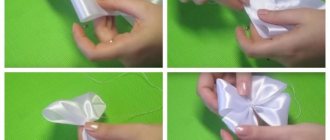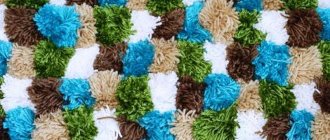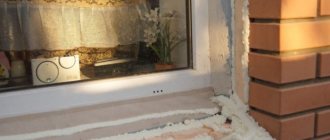Carpets with frayed and sloppy edges spoil the appearance of the room. A carpet with protruding threads does not look aesthetically pleasing, and the whole picture of the room seems unfinished. In stores and in production, edges are processed with industrial overlockers. Models with high pile or dense base can easily be used with professional equipment. At home, edge processing cannot be done using a sewing overlocker. But you can sew the cut by hand. Experienced craftsmen share how to overlay a carpet with their own hands . This does not require special skills or special equipment.
To perform carpet edge processing, the following equipment is required:
- durable threads made of artificial materials;
- sharp “gypsy” needle;
- thimble;
- large sharp scissors.
It is recommended to give preference to synthetic threads made of propylene; they are durable and can easily withstand any load. A stitch made from artificial thread will be denser and more reliable than a stitch made with natural yarn. The color range of synthetic fibers is varied. You can always choose the right tones for your flooring model. The color may differ from the carpet, but at the same time it will highlight it harmoniously. Consider several possible shades to find the best one.
The needle must be sharp and strong so that it can easily pierce the thick coating without breaking.
How to finish the edges with your own hands?
Often this process is performed using a special overlocker. But if there is no way to use it, you can arm yourself with a simple needle and carry out the processing yourself. A loop stitch is required. The edge of the product should be trimmed so that it becomes smooth and does not become shiny. Additionally, you will need several spools of thread.
Reference! The threads must have good strength and quality. Therefore, it is recommended to choose synthetic threads.
An important step is choosing a shade. It can match the carpet palette or become a contrasting element. The needle should be sharp, thin, but large. The edges are finished using a regular loop stitch. The edges must not be folded, they must remain straight.
If you want to add tenderness and volume to the product visually, then replace the threads with a thin cord. The edges will become stronger. The distance between stitches is chosen independently. They can alternate or be at the same distance.
Another processing option is to use tape. It should be synthetic, thin and match the color scheme of the carpet. You can use satin braid for additional decoration.
If the aesthetic side of the issue is not of much concern to the owners of the product, it is worth using available materials:
- Lighter or matches. The edges need to be scorched. You should proceed with caution. If you overdo it with scorching, the carpet will lose its attractive appearance;
- PVA glue. It must be transparent. This option is suitable for products with large pile. This way traces of glue will not be visible on the surface.
You can simply cover it with a plinth. The method can be used provided the product is placed right up to the walls. The carpet is spread in the desired room and all excess is cut off. Then the carpet is installed. The latter can be ordinary or specifically for carpet. In the first case, the product is simply tucked under it. In the second case, it is necessary to cut off a piece from the product commensurate with the dimensions of the plinth and glue it to it.
The set of necessary elements depends on the chosen processing method. Materials needed may include:
- A needle of a suitable size;
- Threads, high quality and strong;
- Satin ribbon;
- Lace of a suitable shade;
- Transparent glue;
- Matches or lighter;
- Skirting board.
Additionally, scissors may be required to trim the edges of the product.
Rug of stones
The idea to create a rug out of stones with my own hands came to me recently while I was working in the garden. I wanted to do something unusual, useful and beautiful for the garden. I had a small handful of river stones lying around in a corner of the garden area and I decided to work with them a little and make my own rock rug. When I finished, the result simply surprised me, I thought, how did such a thought never occur to me before? This is truly wonderful - for those who love nature and everything that brings us closer to it. This homemade product is a piece of wildlife in your home. It can be used almost everywhere - in the kitchen, bathroom, hallway, in front of the fireplace or in some cozy corner in your home. To create a rug of stones with your own hands, you will need to have on hand strong epoxy glue, scissors, river stones of various sizes and colors, and construction mesh of the appropriate color.
To begin, take a piece of construction mesh. On it you will assemble your rug of stones. Decide what size and shape you want your rug to be and cut the mesh accordingly. Although you can first assemble the shape of a rug on a single piece of mesh, and then cut it out along the edges. Do as you feel comfortable.
I wanted to make a round rug, but I started assembling it on a rectangular piece of construction mesh.
To obtain a relatively smooth surface, work with stones of approximately the same size. If you are not interested in having a smooth surface, for example, if the future rug is planned to be used only as decoration, then you can use stones of various sizes. You will get a relief rug. Do you want to use solid colored stones, or contrast the colors by using multi-colored stones. If you want to depict a pattern, make the background of the rug one color and the pattern another. The result will be a very attractive mosaic.
Assemble your rug of stones on the grid and when you decide on its final appearance and consider that it is finished, proceed to gluing.
Start gluing the stones to the mesh. Apply a small amount of strong adhesive to the back of the stone and press into the surface. The glue will leak through the holes in the mesh, so it's best to cover the work surface with something. While gluing the stones, it may happen that your design moves a little from its previous location. So keep this in mind before you start. When you're done with the drawing, continue working on the background. Glue the stones one by one until you get the rug you want. Cut off the remaining edges of the construction mesh with scissors.
Finally, your own DIY stone rug is made.
I placed it near the stairs at the entrance to the garden. He looks very nice there.
You can make a similar rug from stones with your own hands for the bathroom; place it near the bathtub or shower.
Here's another fantastic shoe idea - a tray filled with pebbles.
You can use such a rug as tiles in the bathroom or kitchen. Isn't it beautifully done?
It is also beautiful to use in front of the front door.
Features of the procedure
To process the edges of carpet, special equipment called an overlocker is used. Depending on the type of coating and its color, appropriate threads or tapes are selected that have high strength indicators.
The edges of the carpet processed using an overlocker become more durable and beautiful, they do not unravel or fray, so the service life of the material increases.
Overlocking carpet is carried out in the following cases:
• after cutting the carpet to size, its edges are processed; • if the edges of the old covering are worn out and frayed, they can be cut off and processed with an overlocker.
When choosing a company, take an interest in its reputation and customer reviews, this way you will be sure that the work will be done quickly and efficiently.
You can overlay the edges of the carpet at home, for this you need to purchase special threads and a needle, and you must also have basic knitting skills and be able to manually finish the edges of the floor covering.
Some people have household overlock machines at home; with their help, work can be done very simply and quickly, and its quality will not be worse than when ordering services and professionals.
If you do not have free time and certain skills, then it is better to turn to professionals who have special equipment for this and experience in performing overlocking. They will be able to quickly and efficiently overlay the carpet even when it has a high pile and a dense base, which would be difficult to deal with at home.
Attention!
If you cover the entire surface of the room with carpet and hide the edges of the material under the baseboard, then it is not necessary to overlay them.
Household and industrial
The stores offer a wide selection of overlockers, and therefore it is very difficult for an ordinary buyer to figure out which one is better. You can purchase both household and industrial models of overlockers from such popular brands as Janome, Pfaff, Juki and others
Before you start buying an overlocker, decide for what purpose you need it.
To process carpets and carpets, it is necessary to purchase special carpet equipment. If you plan to earn money this way, then buy a professional overlocker. For rare use at home, a simple and inexpensive 3-thread model will be sufficient.
Do not be afraid of Chinese overlockers and pay great attention to the country of origin, since most well-known companies have branches of their production in various countries around the world and produce high-quality equipment.
Natural carpet: simple edge processing
If the aesthetic side of the issue is not so important to you, you can carry out the treatment using simple improvised means. Thus, the following is carried out:
- Treating carpets and coverings using matches or a lighter. In this case, only the shiny edges are simply singed. This treatment should be carried out with extreme care so as not to burn the floor covering. But this method is more applicable to synthetics. In addition, you need to use it very carefully, as you can easily burn part of the carpet.
- Processing natural carpet using transparent PVA glue or latex mastic. But this method is more suitable for carpets with large pile, since there will be no noticeable traces of glue in it.
Several ways to protect against shedding
Anyone who braided nylon ribbons into braids remembers that their ends were melted with a lit match (so that they would not “crumble”). The same method can be used for synthetic coatings. Any source of open fire (a lighter or a burning candle) seals the threads together, and they will not “crumble”. Consider fire risk
Take precautions
For long-pile carpets and coverings made from natural materials, a good way to treat the edges is with PVA glue, transparent Moment glue, mastic, adhesive tape or transparent gel for gluing decorative accessories to the fabric. The coating should dry well. This option is good if the treated edges are hidden under furniture, because this treatment is short-lived.
The need to treat the edge does not only arise when your carpet has been in use for a long time and is frayed. It happens that we buy flooring by the meter, for a specific room size. In this case, it is necessary to process the cut area.
A very convenient option when you are laying wall-to-wall flooring. The edges of the product are hidden under the baseboard - no processing is required. Moreover, the plinth in this case looks like a decorative item.
Edge processing is required in the following cases:
- Need to downsize;
- The model has a non-standard shape;
- Cut into several pieces;
- Updated (the edges are frayed, but the center is in excellent condition).
Depending on the task at hand, the carpet processing method is chosen.
Some stores offer a service for finishing the edges of the coating upon purchase. You can call a specialist to your home. If you don’t have such an opportunity, it’s okay. After reading our article, you already know how to do it yourself.
Cover the edge with a plinth
If the carpet in your room will lie adjacent to the walls, then the best way to cover its edges is to hide them under the baseboard. To do this, you need to cut the covering with a sharp knife or scissors exactly along the edge of the room and secure it with a plinth. There are two types of skirting boards for these purposes: simple and special skirting boards for carpeting.
When using a simple baseboard, the coating is applied directly under it. And when using a special plinth, a narrow strip is cut from the main piece of carpet, which is glued to this special plinth; the strip of carpet is covered with a decorative strip on top.
Industrial
If you plan to make money using an overlocker, then purchase industrial models. When choosing them, pay attention to reliability and ability to withstand heavy loads over a long period of time. Such equipment must be multifunctional.
First, to promote your business, you can purchase an inexpensive and reliable class 51 overlocker, and when you already have many orders and serious income, you can buy a modern, powerful, industrial four-thread overlocker, which will perform various types of seams and work with both knitted and and with drape, denim fabrics, carpet.
If you are working with thin carpet, then a presser foot lift of 15 mm is sufficient. When working with long-pile coverings, it should be 25 mm. It is better to purchase equipment with automatic lubrication, in which oil is poured into the tank, after which it is pumped through all components, this ensures high-quality operation over a long service life.
Surface tear repair
Applying mastic
If the backing is not damaged, lift the torn section of the carpet, clean off the lint and spread a thin film of mastic onto the backing.
Sealing the tear
Holding the edges of the tear with your hand, smooth the surface of the carpet with a smooth object, such as a soda bottle. Pressing the carpet tightly, move the bottle in the direction from the tear in different directions to evenly distribute the mastic under the carpet between the fibers without squeezing it onto the surface. If glue does come out, remove it immediately with water and carpet cleaning shampoo. Four to five hours after the glue has dried, sew on the loose fibers.
Placing a patch on a bulky pile carpet
Attaching the damaged area to the floor
If the carpet is in tension, place strips of carpet scraps around the damaged area, about 200mm from the edges of the damaged area, and secure them with 25mm furniture nails at 75mm intervals. This procedure reduces the tension of the carpet in the patching area. If the rug is secured with tape or is lying loose on the floor, there is no need to secure it.
Cutting out the damaged area
Make a cardboard stencil to the size of the damaged area and place it on the carpet. Using the blunt side of a linoleum knife blade, part the carpet pile along the edges of the stencil, then push the pile apart with your fingers. Stencil along the backing of the rug, being careful not to cut into the backing, then lift the cut section up at one corner and remove it. Cut a patch from a carpet trim, using the cut section to match the direction of the pile and the pattern and a stencil to make the knife easier to work with.
Installing fabric tape
The patch will be held in place using fabric and mastic tapes on the back of the rug. Cut four strips of fabric so that they are approximately 25mm longer than the sides of the opening. Apply a thin layer of latex mastic to the tape and place the tape under the edges of the hole so that the seam lines are in the center of the tape. Apply a thin layer of glue to the edges of the hole, being careful not to get any glue into the carpet pile.
Attaching a patch
Match the slope of the grain and the pattern of the patch and carpet. Press the patch into place, starting from one corner and working towards the diagonally opposite corner, being careful not to stain the front of the carpet with any adhesive. Push the edges of the hole and patch together and press them together with your palms. Using an awl, loosen any carpet fibers or loops caught in the seam, then use your fingers to smooth the carpet fibers and patches until they blend together and the seam is no longer visible. Load the seam with a stack of books for several hours. If the carpet is stretched on the grippers, after approximately five hours, remove the temporarily nailed strips of carpet scraps and restore tension to the carpet using the tension tool.
Equipment
You can overlock carpet using high- and low-speed special machines.
You can overlock carpet using high- and low-speed special machines (overlockers). Using such equipment, you can not only make a neat seam around the perimeter of the product, but also make a fringe.
There are compact models on sale for use at home or for providing related services on-site. The price of such equipment is more reasonable in comparison with production models. However, compact portable units cannot be used to process rubber-based industrial carpets. They are only suitable for household carpet made from artificial or natural materials.
How to make a subfloor for a loggia or balcony with your own hands?
Large units are usually used in various industries. Most overlockers are heavy and large devices that are not designed to be transported from place to place, so processing is usually carried out in a special workshop.
Important Details
They are used not only for carpets, but also for rugs, rugs, and carpet runners. How to treat the edge of a carpet to make it durable? It is very important to choose strong, smooth and flexible wear-resistant threads. These qualities are met by threads made of polypropylene or polyester. Their advantages:
- more durable compared to natural threads made of cotton and wool;
- are resistant to solvents;
- frost-resistant;
- waterproof;
- various colors.
The disadvantage of artificial threads is their low resistance to sunlight; they lose their color under their influence.
The appearance of the edge of the carpet determines how aesthetically pleasing the product will look, and the durability determines how long it will last. Use tight stitches to carefully cover all edges. Professionals from specialized firms are more successful in this task. Usually they provide services permanently or on-site to the customer, if the thickness of the pile and the density of the carpet base do not impose particularly complex requirements. If desired, fringe can be sewn to the edge of the product.
How to trim the edges of carpet with your own hands
Not everyone can afford to call a specialist to process the edges of the coating. Some people have little finances, some live far from the city or are used to doing everything on their own, etc.
What you need to overlock carpet at home
- synthetic threads or tape;
- very sharp, thick and reliable needle with a large eye;
- thimble to protect fingers;
- powerful scissors.
Advice! To calculate the approximate amount of thread for finishing the edges, multiply the total length of all sides of the fabric by 10. You will get an approximate figure, so take it with a margin.
Overlocking at home: step-by-step instructions
At first glance, the procedure is simple, especially for those who know how to hold a needle in their hands, but finishing the edges can take a very long time. The procedure is performed using a regular loop stitch.
First you need to evenly measure and cut the edges of the covering.
Now point by point:
- We make the first puncture at a distance of 5-15 mm from the edge. This indentation depends on the thickness of the coating - the thicker it is, the greater the indentation.
- We stretch the thread and throw it on the needle. Next, pull the thread to the left and tighten it well around the edge of the carpet.
- Insert the needle into the same hole again. We pull the thread again and throw it on the needle. Now pull the thread to the right and tighten it.
- We retreat a short distance from the first puncture and make a second one. The distance between the punctures depends on the density of your overlock - the smaller, the denser.
- We repeat the previous steps.
Loop stitch
Another option is to sew the rug with a buttonhole stitch. Since a standard home sewing machine cannot handle the rug, you will have to sew it by hand. Choose strong, thick threads or thin lace for processing, because the floor covering is something that is subject to quite intense wear. You can choose threads to match the coating, which will be almost invisible. Or, on the contrary, you can use a contrasting color or a color that will resonate with the details of your interior or the pattern of the flooring. It depends on your imagination and taste. You can combine several colors, use textured laces, or group stitches to form a specific pattern.
Cutters
Hand-held devices that allow you to make straight cuts in carpet without much effort. They come in several varieties and are suitable for certain types of this flooring:
- Universal cutters for carpet and linoleum. They have a trapezoidal cutting element, made in such a way that when cutting, the pile does not fall under it.
- Universal cutters for textile coverings. Using them you can cut carpet, PVC and materials with a foam base.
- Flooring cutters with jute base. In addition, they can be used to cut PVC, but such a tool is not at all suitable for those that have a foam base.
We suggest you read: How to wash a cashmere coat at home
Most of them come with a set of replacement blades.
Types
Household equipment is intended for use at home , and therefore its cost is low. With it you can sew medium fabrics and thin carpet. Any thread is suitable for it ; for household use, they usually come on small spools.
To ensure uninterrupted and long-term operation of a household overlocker, it is imperative to follow the recommendations in the operating instructions. It must indicate what threads and needles can be used and what fabrics can be worked with.
Modern household economy-class overlockers are multifunctional equipment that can make four- or three-thread seams, and when using plugs, a two-thread seam.
More expensive models of overlockers can make covered, flat and other types of seams. To work with carpet, you need to purchase a carpet lock , but the cost of such equipment will be higher, since it performs more functions.
It is impossible to carry out large volumes of work with a household overlocker; it is designed for small and short-term loads, and to carry out large-scale work, it is necessary to purchase industrial equipment.
Other methods for overlaying carpet at home
If you do not want to treat carpet with threads, you can use the following options:
- Satin, grosgrain, nylon or polyester ribbons are suitable. They are wider than the threads, which will allow you to hide the cut of the rug in fewer stitches.
- If aesthetics are not important, the edge can be melted with fire using a lighter. Be very careful not to burn the rug.
- Another affordable way to prevent carpet wear is to treat the cut with PVA glue and dry it thoroughly.
Now you know how to overlay a carpet at home . You can overlay carpet or any other carpet product in the same way. If you are not sure that you can make stitches accurately, it is better to contact a specialist. You need to trust the professionals, especially if you need to fix the cut of expensive carpeting.
If your efforts to revive the old carpet have not brought results, then it is better to go to our carpet catalog and choose any one you like, with delivery throughout Moscow and Russia.
DIY carpet repair
Work execution technology
For those who don’t know, we suggest mastering the simplest seam – “manual overlock”. We fasten the thread.
- We retreat from the edge by 0.7-1.5 cm (the thicker the carpet, the larger the indentation) and stick the needle into the carpet.
- Thread the thread onto the needle, pull it to the left and tighten.
- We stick a needle into the same puncture, then put a thread on it and pull it to the right, tighten it.
- Having retreated 0.7-1.5 cm from the first puncture, stick a needle and throw a thread on it.
- Holding the corner of the previous loop, pull the thread to the left and tighten.
- We stick the needle into the same puncture, throw a thread over it, pull it to the right and tighten it.
What you will need
There are two ways to process the cut edge of a carpet: using cloth or thread. To do this, prepare the following materials and tools:
- Strong thread. For this it is better to use synthetic fiber. It is more resistant to abrasion, does not fray when sewing and has a sufficient service life;
- Decorative cord. This material should be chosen to match the main color of the coating;
- Cover the open side with a suitable fabric. To do this, fabric is selected that harmonizes with the carpet. It is better if it is synthetic;
- You will also need a thimble (it is advisable to choose a metal version) and a long needle (gypsy).
For edging with threads, first trim the side using scissors. You can also give the object any shape: circle, oval, flower, and so on. Then sew the edge with your chosen material using a loop stitch. You can also use the crossed stitch option.
In order to cover the cut side with fabric, you need to cut it into strips. Next, carefully wrap the edge of the carpet with a strip and stitch through it.











